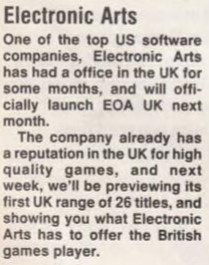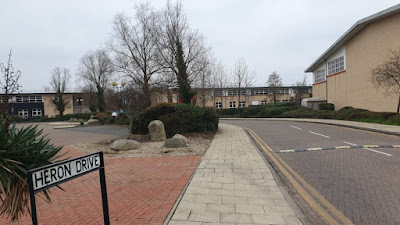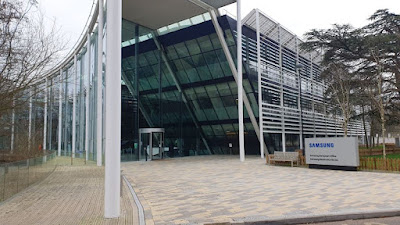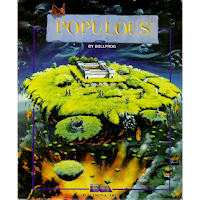"American Invaders on the Way," was how COMPUTER & VIDEOGAMES announced the existence of Electronic Arts to British computer owners. "Electronic Arts is the name of a new American software house set up by a group of independent games designers." (January 1984 page 16 ). The news was a little out of date. The company had been founded two years previously by ex-Apple Director Trip Hawkins. Now, for the first time, its games would be available in the UK, distributed by Centresoft, who would go on to launch US Gold later in 1984. "If US are Gold then we must be Platinum!" Trip Hawkins later told C&VG*
Electronic Arts slipped through US Gold's grasp. The company instead agreed that German company Ariolasoft would distribute their titles in Europe. This deal expired in April 1987 by which time Electronic Arts was ready to join the growing number of American companies distributing their own games in the UK.
Ground Floor, 2-3 Cursitor Street, London EC4A
The Companies House record for Electronic Arts (company number 02057591) shows it was founded in September 1986. It started out as a business called Hazlist Ltd, based at 70/74 City Road, London EC1Y. Then December 1986 sees a change of address to Ground Floor, 2-3 Cursitor Street, London EC4A and the company changes its name to EOA Ltd in January 1987. Hazlist Ltd was an off the shelf company, that's one which has been set up but has no trading history. They are ideal for anyone who want to quickly establish a company; Newsfield, publishers of CRASH and ZZAP64!, was founded in exactly the same way. The question is, at what point did Electronic Arts Inc step in and buy Hazlist Ltd for themselves as the foundation for their new company?
Companies House records Trip Hawkins (or rather, W. Hawkins III) appointed as a director on 19th January 1987 along with Tim Mott, who is also associated with the early days of Electronic Arts Inc. That confirms the name change and move are associated with EA buying Hazlist Ltd, rather than being the actions of solicitors shuffling their off the shelf companies around for boring administrative reasons. This is terribly interesting but also frustrating because I'd neglected to get a picture of Cursitor Street. Hang on.
Here it is.
 |
| July 2023 |
It's long gone. Fortunately the Streetview cameras caught the previous building before it was swept out of existence around 2013. It was an unremarkable 1950s/60s office block and presumably EA used space behind the ground floor windows facing out onto the street.
Why call the UK subsidiary EOA instead of Electronic Arts? The EA logo at the time was a square, a circle, and a triangle next to each other and a similar effect was used when writing out the company name on packaging.
 |
| POPULAR COMPUTING WEEKLY 21-27 August 1987 page 10 |
EOA clearly wasn't working as a name and was formally changed to Electronic Arts Ltd on 16th July 1987 (at 3pm). August saw PERSONAL COMPUTER WEEKLY announce a list of 26 titles EA planned to release in advance of its formal launch (14-20 August 1987 page 7). The bulk of the games are for the Commodore 64, PC, Amiga, and Atari ST. Two games are also listed for the Amstrad (Archon and Arctic Fox) but none for the Spectrum. The Ramjam Corporation had already converted Archon to the Spectrum for Ariolasoft in 1985 and the Amstrad version was handled for EA by a company called Lynsoft (about who I know nothing). The Zen Room handled Arctic Fox for the Amstrad and later the Spectrum. I'm going out on a limb and guessing the Spectrum version was further behind which was why it wasn't mentioned on EA's list of launch titles. I'm going further out on a limb and assuming The Zen Room was a programming team from CRL and within a year that relationship would sour.
Langley Business Centre, 11-49 Station Road, Langley, Berkshire, SL3
Electronics Arts Ltd introduced itself to the world at the PCW Show in September 1987. CRASH followed this up by making a two page interview with Trip Hawkins the centrepiece of it's show coverage in the November 1987 issue. This always seemed like an odd decision, given EA hadn't released or advertised any Spectrum games at this point. Was the interview intended for Newsfield's new multi-format magazine THE GAMES MACHINE, but wasn't used for some reason and got repurposed. Anyway, CRASH briefly mentions that UK software houses CRL and Nexus have signed up with EA as "affiliated labels." EA would handle distribution of games for its affiliates leaving them to "concentrate on product and make more product and make better product." Martech also signed up as an affiliate by December 1987. EA's first game in the UK is probably PHM Pegasus. That's the first game to be advertised starting around September/October 1987 . It's a Lucasfilm game. This is also odd. Activision distributed Lucasfilm games in the UK and, apart from PHM Pegasus and it's sequel Strike Fleet, they continued to do so all the way up to 1988's Zak McKracken and the Alien Mindbenders.
Then the affiliates programme starts to go wrong. Nexus went bankrupt, due to "historic indebtedness," in December 1987. Next CRL and EA split acrimoniously in June 1988. "Rumours abound that EA are far from happy with the software that affiliate label CRL have been producing," wrote ACE (June 1988 page 11). The following month the news for CRL was worse: "CRL are alleging that EA owe them a lot of money under the terms of the distribution agreement signed a year ago. EA are countering with the claim that CRL's games just weren't of the 'high industry standard' stipulated." The writs started flying and, as so often happens, once things went to law the story disappears from magazines. The comment about the standard of the games is interesting, given EA were caught out by the furore over CRL's game Jack the Ripper. The first game to be rated 18 by the BBFC and the third in CRL's moral panic bating series, the two previous games Dracula and Frankenstein had been rated 15. WH Smith refused to stock Jack the Ripper describing it as "'pretty nasty," and "not suitable for their software buying public"; SINCLAIR USER (December 1987 page 20). John Forrest, a director of EA, told POPULAR COMPUTING WEEKLY: "We knew it would be certified, but 1 thought it was in the same genre as other releases, so we have not really informed dealers in. any major way." (November 19-27 1987 page 1)
CRL's Jeff Lee described the aftermath of the fall out to Graeme Mason as part of an interview for RETRO GAMER and you can read some of his unused interview at wizwords.net :"In June 1988, half the staff were made redundant because Electronic Arts either held back or completely stopped payment (EA were in dispute with CRL over the their distribution agreement); this was catastrophic because they were our exclusive distributor." Jeff also briefly mentions the terms of "the distribution arrangement we had with Electronic Arts, which had a contractual requirement on us to supply 10 SKU's (single title on a single format) per month." This brings to mind the deal Imagine did with Marshall Cavendish and another between Odin and Telecomsoft, to supply 10 games in one year for their Firebird label. Martech also ended up opting out of the affiliates label; annoyingly I've managed to loose the reference to this but I'm 75% sure it was around December 1988.
EA published a game called Fusion in 1988. It received middling to good reviews but didn't set the world on fire. The developer of Fusion was Bullfrog and their second game Populous was a massive successes and won every review award going.
 |
| THE ONE September 1989 page 17 |
 |
| March 2023 |
 |
| March 2023 |
 |
| April 2023 |











No comments:
Post a Comment